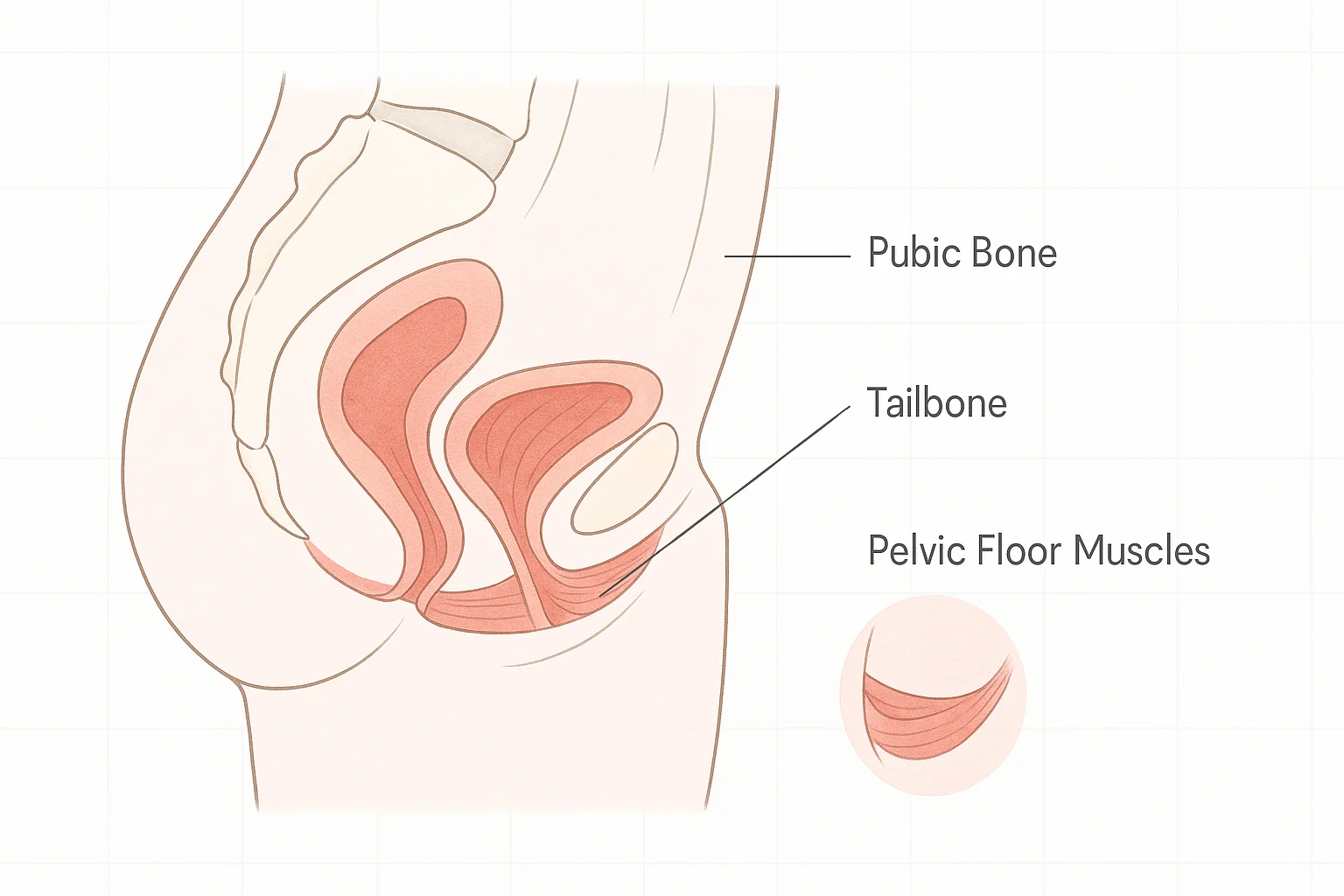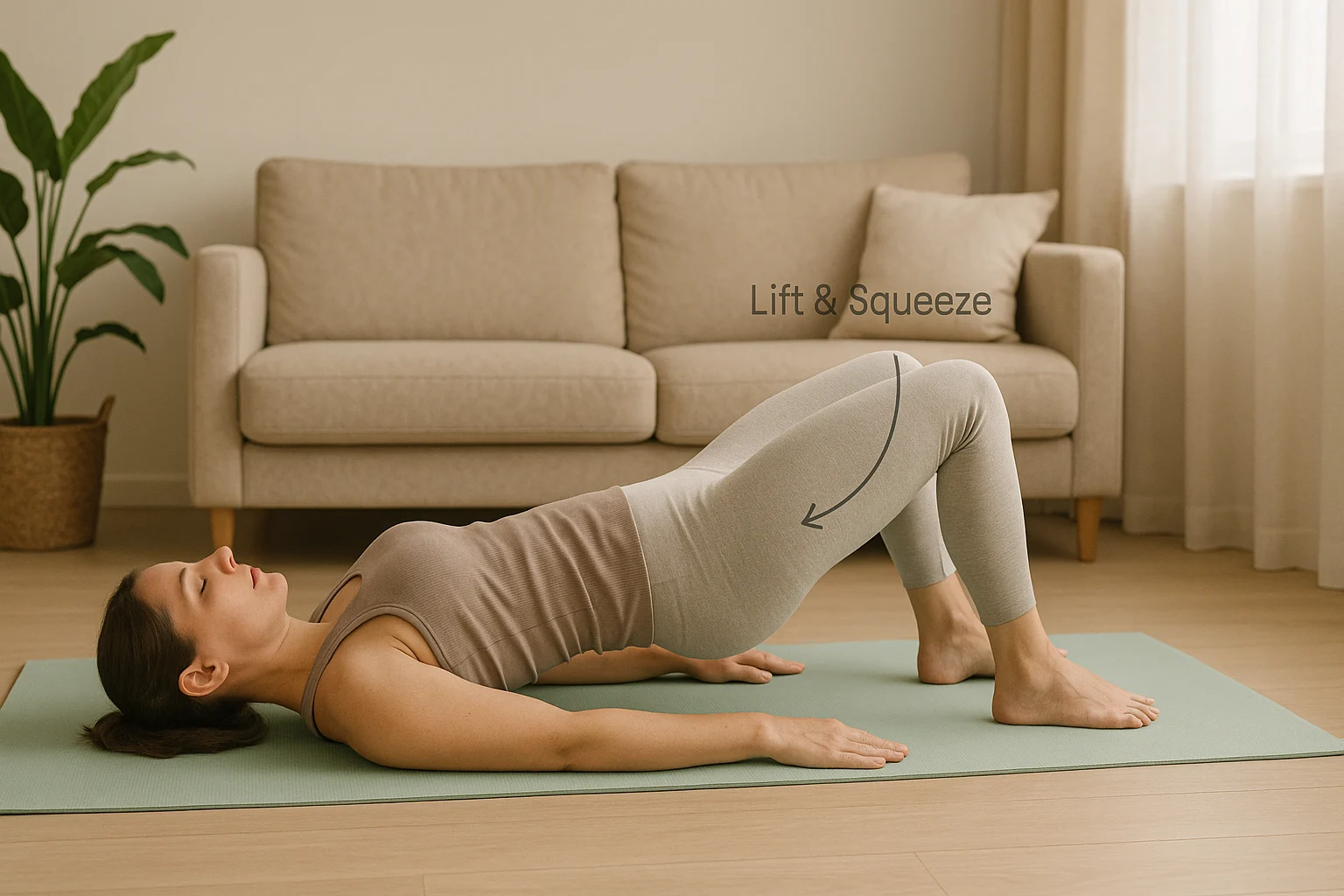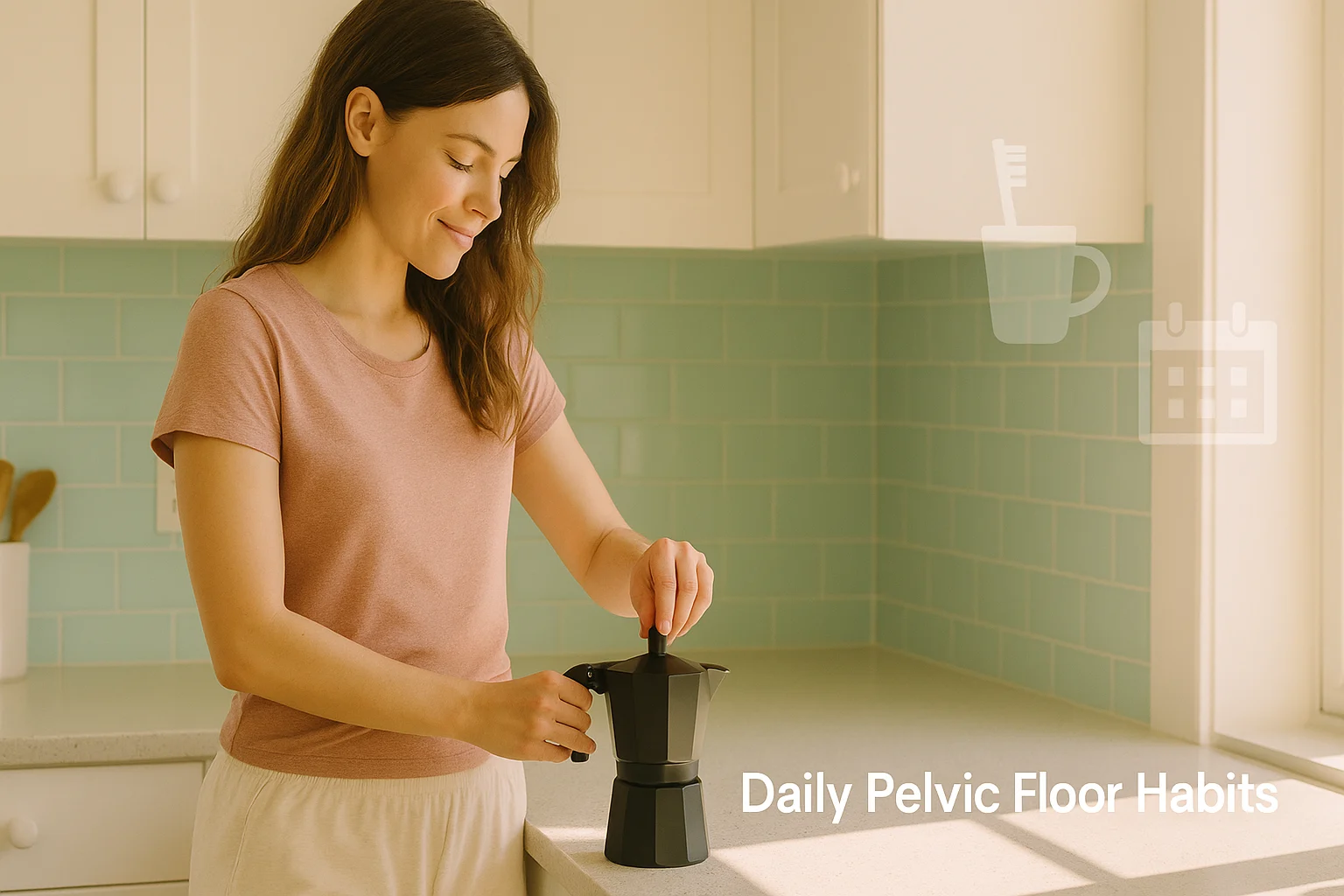
Start small, feel confident — reduce leaks when you laugh or sneeze with consistent practice! New to pelvic floor exercises for beginners? You’re in the right place. Think of these muscles as a quiet support system for your bladder, bowels, and sexual health. With a simple, beginner-friendly routine, you can build control and core support at a gentle pace. This article is part of our women’s pelvic health series — for the full picture, check out women’s pelvic health.
Take the 1-Minute Starter QuizHeads up: Pelvic floor work should feel gentle and controlled—not painful. If you notice pelvic pain, new leakage, or prolapse symptoms, stop and consult a qualified pelvic floor physical therapist or clinician for personal guidance.
Table of Contents
- Key Takeaways for Beginners
- What Are Pelvic Floor Muscles?
- Why Pelvic Floor Exercises Matter
- How to Locate Your Pelvic Floor Muscles
- Pelvic Floor Workout for Women: Getting Started
- 1-Minute Starter Quiz & Routine
- Daily Tips for Pelvic Floor Exercises for Beginners
- Common Mistakes When You’re Starting
- When to Consult a Pelvic Floor Therapist
- Frequently Asked Questions About Pelvic Floor Exercises for Beginners
- Start Your Pelvic Floor Journey Today
Key Takeaways for Beginners
These pelvic floor exercises for beginners set you up for success.
- Hidden Powerhouse: Your pelvic floor acts like a sling, supporting your organs and improving bladder control, core stability, and intimacy through pelvic floor training.
- Find the Right Muscles: Learn to isolate your pelvic floor with tricks like stopping urine flow (use sparingly).
- Consistency Beats Intensity: Gentle, daily practice beats occasional hard efforts.
- Listen to Your Body: Stop if you feel pain. Awareness develops over time, and professional help is available if needed.
- Patience Pays Off: With steady work, most people notice changes in a few weeks to months.
What Are Pelvic Floor Muscles?
Picture a hammock stretching across the base of your pelvis — that’s your pelvic floor! These muscles and connective tissues span from your pubic bone to your tailbone and between your sit bones. For women, pelvic floor strength training targets these muscles to support critical functions:
- Support: They hold up your bladder, uterus, and rectum, acting as the core’s foundation.
- Control: They manage bladder and bowel functions, helping prevent leaks.
- Stability: They team up with abdominal and back muscles for a strong core.
- Sexual Function: They can enhance sensation and comfort.
- Childbirth: They guide the baby during delivery and need strength and flexibility.
Understanding your pelvic floor is the first step. Without that awareness, it’s like lifting weights without knowing which muscle you’re targeting.

This simple diagram shows where the pelvic floor sits—think “hammock” between pubic bone and tailbone.
Why Pelvic Floor Exercises Matter for Women
A stronger pelvic floor can make everyday life easier. Here’s how a beginner routine helps—without overdoing it:
- Bladder Control: May help reduce leaks during laughing, coughing, or sneezing (stress incontinence), common after childbirth or with age. See the Mayo Clinic how-to and NIDDK overview.
- Organ Support: Pelvic floor muscle training (PFMT) is recommended as a first-line approach for stress urinary incontinence in women; see NICE NG123 and its quality standard.
- Core Strength: Enhance stability with your abdominal muscles and diaphragm, potentially easing back discomfort.
- Post-Childbirth Recovery: Rebuild strength after pregnancy and delivery with targeted pelvic floor exercises for post-pregnancy recovery.
- Intimacy Boost: May increase comfort and confidence during sexual activity.
- Prevention: Regular practice can help safeguard against future issues, like a small insurance policy for your body.
“Your pelvic floor is your body’s natural support system. Strengthening it is an investment in your comfort and confidence.”
Further reading: a 2023 review on PFMT and quality of life in women with incontinence (open access).
This post has affiliate links. We may earn a commission. Learn more.
How to Locate Your Pelvic Floor Muscles
Before you start, you need to feel these internal muscles. It’s tricky, but these methods help:
1. Stopping Urine Flow (Use Once)
While peeing, try stopping the flow mid-stream. The muscles you engage are your pelvic floor. Note: Only do this once or twice to identify them, as regular stopping can disrupt bladder function.
2. Holding Gas
Imagine preventing gas from escaping. Squeeze and lift the muscles around your anus upward, as if pulling away from the chair.
3. Vaginal Squeeze
Picture holding a tampon in place or gently drawing something upward inside your vagina. Feel a subtle lift and squeeze.
Key Feeling: Aim for a gentle lift and squeeze up and in, not pushing down. Avoid tensing your glutes, thighs, or abs. Try lying down with a hand on your lower abdomen to ensure it stays relaxed.
Pelvic Floor Workout for Women: Getting Started
Once you’ve identified your pelvic floor, it’s time to begin. If you’re expecting, you might also explore pelvic floor exercises during pregnancy for tailored guidance. Consistency matters more than intensity, so let’s start simple with a pelvic floor workout for women you can repeat daily.
Basic Squeeze (Kegel) for Pelvic Floor Strength Training
This foundational move builds awareness and strength for a beginner routine.
- Get Comfortable: Lie down with knees bent, feet hip-width apart.
- Breathe: Inhale deeply, letting your belly rise. Exhale to relax.
- Squeeze: On an exhale, gently lift and squeeze your pelvic floor, like stopping urine and gas. Keep other muscles relaxed.
- Hold: Maintain for 2–3 seconds, focusing on the lift.
- Relax: Release fully for 4–6 seconds, letting muscles soften.
- Repeat: Do 5–8 squeezes, resting between each.
Starting Goal: 5–8 reps, 2–3 second holds, 4–6 second releases, 1–3 sets daily.

Adding Variety: Slow and Fast Squeezes
Once you’re comfortable with the basics, add these variations:
Slow Squeezes (Endurance)
Build staying power with longer holds.
- Hold the lift for 4–5 seconds, relax for 8–10 seconds.
- Do 5–8 reps, keeping breathing steady.
Fast Squeezes (Quick Response)
Train quick reactions (think sneezes or coughs) with short, crisp squeezes.
- Quickly squeeze and release in a “flick” motion.
- Do 5–8 reps, fully relaxing after each.
Sample Beginner Routine
| Step | Action | Reps/Time |
|---|---|---|
| Warm-up | Deep breaths, relax body | 3–5 breaths |
| Slow Squeezes | Hold 4–5 seconds, relax 8–10 seconds | 5 reps |
| Fast Squeezes | Quick squeeze and release | 5 reps |
| Cool-down | Deep breaths, full relaxation | 3–5 breaths |
Aim for 2–3 short sessions a day. If that feels like too much, start with one and build up.
1-Minute Starter Quiz & Routine
Answer four quick questions to get a gentle plan that fits your starting point. No email, no sign-in—just practical steps.
Your Personalized Starter Routine
Daily Tips for Pelvic Floor Exercises for Beginners
Consistency is key. Here’s how to make this a habit without overthinking it:
- Start Small: A few correct squeezes beat many incorrect ones.
- Spread It Out: Do 2–3 short sessions daily (morning, midday, evening).
- Integrate into Routine: Try during tooth brushing, at red lights, or while brewing coffee.
- Listen to Your Body: Stop if you feel pain or strain.
- Avoid Overdoing It: Too many reps can tire muscles. Follow beginner guidelines.
- Relax Fully: Let muscles soften between squeezes for flexibility.
- Be Patient: Results may take 4–12 weeks, depending on consistency and individual factors.
- Use Reminders: Set phone alerts or place sticky notes as cues.
Success Story: Sarah, 35, felt embarrassed by leaks after childbirth. Three months of short daily sets helped her regain confidence — now she laughs freely without worry.

Common Mistakes When You’re Starting
When doing pelvic floor exercises for beginners, avoid these common pitfalls to get the most from your training.
- Holding Your Breath: Breathe normally to avoid abdominal pressure.
- Tensing Other Muscles: Keep glutes, thighs, and abs relaxed. Check by placing a hand on your stomach.
- Pushing Down: Always lift up and in, not out, to avoid weakening muscles.
- Over-Training: Too many reps can cause fatigue. Follow beginner guidelines.
- Skipping Relaxation: Full relaxation between squeezes prevents tension.
- Giving Up Early: Stay consistent, even if results take time.
When to Consult a Pelvic Floor Physical Therapist
While these exercises are generally safe, professional help can be valuable if:
- You can’t feel your pelvic floor muscles after trying identification methods.
- You experience pain during or after exercises, or have chronic pelvic pain.
- Symptoms like leaks don’t improve after weeks of consistent practice.
- Symptoms worsen, suggesting incorrect technique or underlying issues.
- You have conditions like prolapse, chronic constipation, or are post-childbirth.
A pelvic floor physical therapist (PFPT) can assess your muscles, teach proper technique, and tailor a plan using tools like biofeedback. You might also consider pelvic floor massage techniques as a complementary approach to pelvic floor exercises for beginners.
Frequently Asked Questions About Pelvic Floor Exercises for Beginners
Start Your Pelvic Floor Journey Today
Strengthening your pelvic floor is a powerful act of self-care, much like embracing self-love practices for overall wellness. You’re building better bladder control, core strength, and confidence. Start small, stay consistent, and celebrate every step forward. Your stronger, more confident self awaits with practice!
